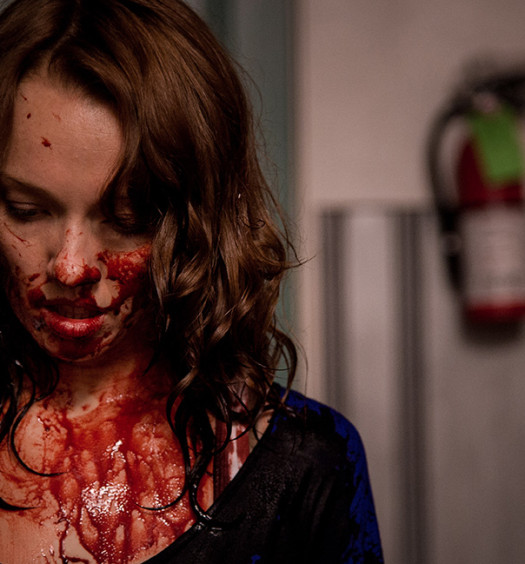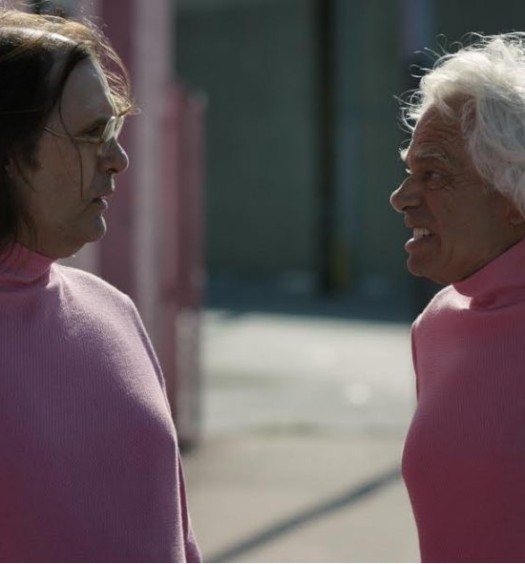GREEN ROOM is one of the best movies I’ve seen this year, so when I was given the opportunity to interview director Jeremy Saulnier I jumped at the chance. Though it deals with a pretty extreme situation GREEN ROOM still manages to feel personal on so many levels. The violence in particular left an impression on me that two weeks out I still haven’t been able to shake. Speaking with Jeremy we explore his personal ties to the punk scene from his youth, his thoughts on cinematic language, and what it’s like to film in such confined spaces.
Jeremy: Oh yeah man, I think my fondest memories of cinema would be growing up in Washington D.C. and watching the Sunday matinee Creature Feature, Captain 20 on channel WDCA, like The Beast from 20,000 Fathom. It was just fantastic, and that’s how I got into film actually, through makeup effects and building miniatures and trying to photograph dioramas. I’m on record saying that the opening to Dawn of the Dead and several of the kills in Friday the 13th Part 3 are seared into my memory because my older cousins from Western Virginia when I was like eight or nine they had cable, they had VHS, and they would rent these movies or tape them off of cable and they would make me watch these kills over and over again, they were totally messing with my brain, and I think the way I cope with that is to try to reverse engineer it. That was really fun, I got into Tom Savini and all that jazz, the atmosphere is what I fell in love with, I love being terrified, I love the excitement, the thrill of terror and watching films like John Carpenter’s The Thing, An American Werewolf in London, those makeup effects they had a really profound influence on my film career in that I fell in love with the arts and crafts of it all.
Jeremy: Well I tend to approach it in a way that’s as authentic as I can make it. That’s just how I perceive violence. The way I see it in the real world it often seems less spectacular than it’s portrayed in movies and to sort of get that feeling of authenticity and have the audience really feel the peril of these experiences. I tend towards brutal and awkward and ill timed, where things just don’t go off with perfect choreography, there isn’t a lot of technical finesse to it but I just try to make it seem like real people are doing it to each other.
Jeremy: You know when you try and stay grounded in that real world that you’re trying to build, its huge to do that. I think a lot people know cinematic language all too well, and so many times in movies I can tell when there’s going to be a death, I can tell when there’s going to be a lead up or when you linger on somebody. I won’t name names but I was watching one of the recent true life war movies and I could tell every single time a navy seal was going to die. It’s cinematic language, there’s no question. I like to be as you said unceremonious as hell. It could sneak up on you like it does the character.
Jeremy: Honestly, it’s one of these things were filmmakers have these little ideas that pop into their heads and being in the punk rock hardcore scene and being around music venues and just loving that world, it seemed like a natural place to set a siege film because I wanted to capture the energy of a live performance I wanted it to take place in the music scene and within the music scene you have parking lots, you have vans, and you have concert venues, and going deeper into that concert scenario I was thinking a green room is just a siege waiting to happen. You have so many crazy things that go on backstage during rock shows and punk shows that it would be the most interesting and the most realistic to stage a genre film, not just a siege film, it ended up being a siege film because of the nature of the confined space, but I had that idea and I just wanted to set the stage and I’m glad I’m the first to do it. I was surprised actually.
Jeremy: Yeah, the first 15 minutes of the movie are pulled from personal experience and those are my good friends growing up in the hardcore punk scene. I was in a band, I was a yeller in a hardcore band and my buddies were in a touring punk rock band, and when I was writing the movie I got to touch base with my friends and caught up and started interviewing them about stories they experienced on the road and I have my experiences so it was really personal and authentic. At least in that regard, I mean it might not be everybody’s experience but it certainly was the experience of that of my friends and myself so I stand by the authenticity because I was there.
Jeremy: Yeah, I usually prefer to have a less contained environment, after my first film Murder Party, I swore off ever doing that again, that takes place in a Brooklyn warehouse overnight during Halloween. And I was confined to this singles location, with an ensemble cast. I felt very limited but I had to go against my vow and sort of retread that ground for GREEN ROOM because the scenario demanded it but we have a lot more layers in GREEN ROOM but I think I definitely I don’t want to do that again anytime soon. I might have to turn back to the enclosed scenario but I know if I had my choice I would switch it up, I’d like some fresh air next time. And more diverse set of locations and not so many scenes that aren’t you know, 15 pages long.
Jeremy: I don’t know, you mean if they don’t play Nazi Punks? I don’t know. You know it could be argued that it’s almost a jailhouse posturing like when you show a bit of aggression you get some respect, that’s what they basically did by playing Nazi Punks where there is this initial charge in the air but aggression but it’s their follow up song that really wins them over. It’s a little dangerous but it’s a little playful too, I think that’s what actually gives them the respect to keep going.
Jeremy: Oh it’s great, and they are a talented cast. The thing it’s hard to find people 25 and under with that much experience so I knew going into GREEN ROOM how much weight I was putting their shoulders as an ensemble. I was really glad I could find that not only was this the cast I needed but they had the enthusiasm that I really fed off of. And we fed off each other’s energy and again the issue is with these contained scenarios, so much is in continuity, so much is like developing a live performance, you’re very vulnerable to each other, as far as like you can’t have a single bad performer in that room or else we’re all doomed. They had to put themselves in my hands and I had to put them in my hands, it was really great. They were of course delighted today’s the opportunity to be in a type of film they aren’t often cast in. Imogen Poots had a blast, she had to get feral and face painting and all kinds of nasty and she really enjoyed that.
Jeremy: Oh yeah, blocking in a single room is absolutely a nightmare, it gets to be exhausting. Because everything you do, it’s not just like block this scene and then hope it works out for the best, because it take place almost an entire hour of the film in that room, every decision you make is baked into every subsequent scene you shoot there. When a body drops and hits the floor that body has to stay there for 14 more shooting days, you have to get stunt people to come in there to lie on the ground with blood stains, with close ups, and it became so tough to actually move the camera around, your moving furniture every take, it was certainly wearing on us, but luckily we had enough time on that sound stage to kind of really get the performances we needed and get the coverage set that my editor can finish in the post production process.
Jeremy: Oh that was just for Patrick to sink his teeth into. Because his character has such a profound influence and this authority but I definitely didn’t put it all on the page, I wanted to make sure it was below the surface and implied and not sort of spelled out. Patrick did his own research as well but that was just to help augment the material and have him get his bearings, because he came on board last minute, he came on board 10 days before we shot his first scene, just an extra biography to steer him as he was playing Darcy.
The shoot was scheduled for 37 days. It’s crazy this day and age they don’t give you enough time to shoot movies anymore which is a shame. It’s funny, it’s the same amount of time to shoot Blue Ruin so I get ten times the budget but the same amount of days, and we had a lot more going on.
I have a bunch of stuff still in development but I never know until they get green lit. but I have a lot of cool exciting projects I’m going for, some more studio level, some are really nice independents and eventually my goal is to direct something but I will one day I return to the writer’s chair and that to me is the peaceful process, it’s the most enjoyable, it’s the most pure.
Jeremy: Yes, there are two correct answers but I don’t give them out, just the nature in how we made the film. There’s one answer that only me and Anton Yelchin know. And there’s one that audience members can sort of guess themselves, there’s a little queue in there somewhere but I like to have that be a little bit of a mystery.































